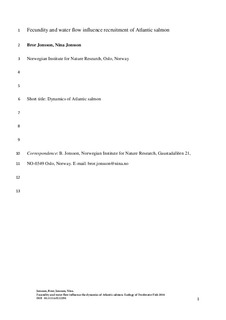Fecundity and water flow influence the dynamics of Atlantic salmon
Journal article, Peer reviewed
Accepted version

Åpne
Permanent lenke
http://hdl.handle.net/11250/2477962Utgivelsesdato
2016Metadata
Vis full innførselSamlinger
- Publikasjoner fra CRIStin - NINA [2364]
- Scientific publications [1392]
Originalversjon
10.1111/eff.12294Sammendrag
Populations are retained at reduced levels by resource competition and environmental stochasticity. In the Norwegian River Imsa, the relationship between fecundity of Atlantic salmon (Salmo salar) spawners and number of smolts per unit river area was investigated for cohorts spawned from 1976 to 2011. Annual number of smolts produced per unit area was best described by a multiplicative model and increased with the fecundity of the females as proxy for number of eggs deposited and the minimum water flow in August towards the end of the first growth season. Mean monthly water temperature, or water flow in any other month during the first year, had no significant effect on number of smolts produced. At sea, there was an almost linear relationship between number of emigrating smolts and returning adults, possibly because population abundance of Atlantic salmon is low relative to the carrying capacity in the ocean. Thus, both number of eggs spawned and minimum water flow in late summer influenced population abundance in the present river. density dependence, River Imsa, Salmo salar, sea survival, stock–recruitment
